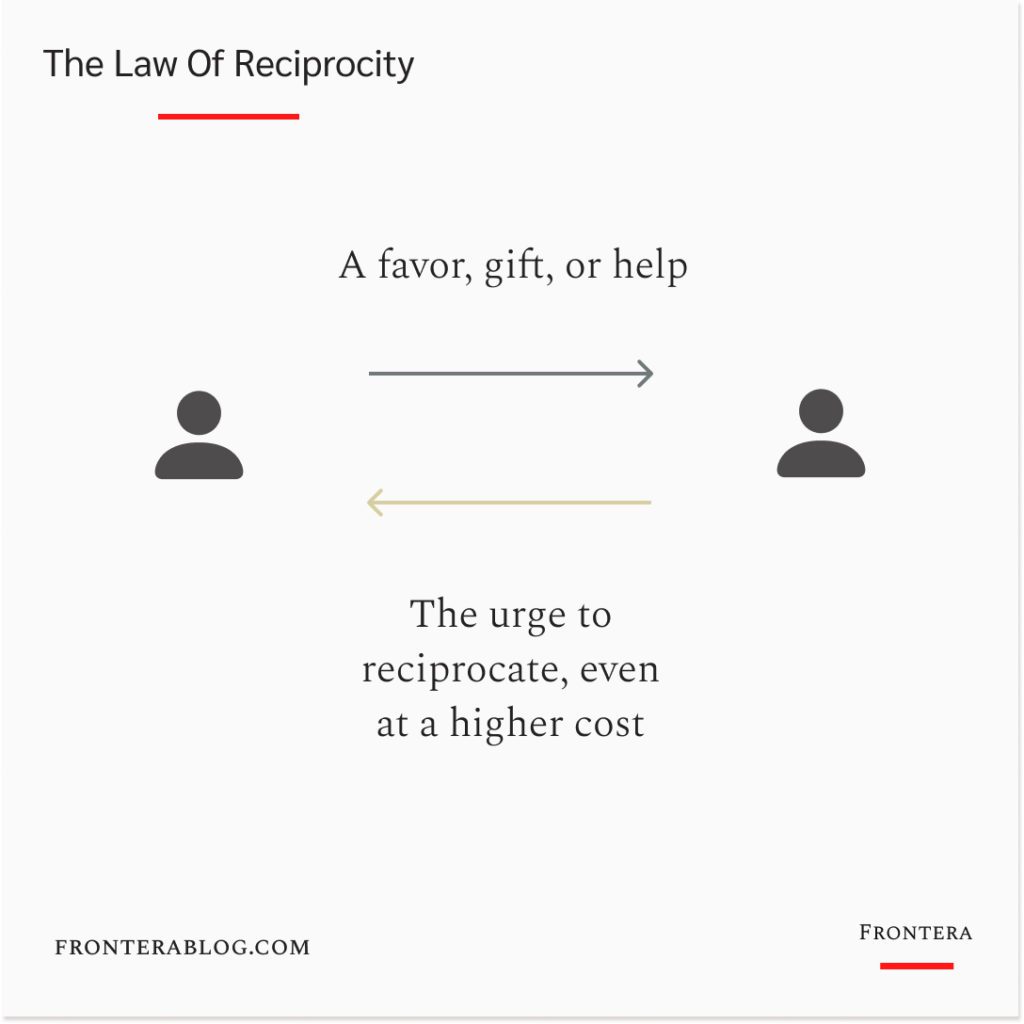In 1985, Ethiopia was in a humanitarian crisis.
Civil war, poverty, famine…
Ethiopians dealt with many calamities at the same time.
The suffering was immense.
As these disasters were ongoing, newspapers covered a story about a five thousand dollars aid between Mexico and Ethiopia.
But one detail surprised everybody.
The side that sent the aid was not Mexico.
It was Ethiopia.
A big earthquake hit Mexico City the same year and killed thousands of Mexicans.
So Ethiopian Red Cross members sent whatever they can to help Mexicans who lost their homes and families.
Why did Ethiopians send that aid despite needing it more than any other country?
This is how the Ethiopian Red Cross explained it in their statement:
“Mexico had supported Ethiopia when forces of Italian dictator Benito Mussolini invaded Ethiopia in 1935.”
Meaning of the law of reciprocity
Robert Cialdini used this powerful story to explain the law of reciprocity’s meaning in his book Influence.
When we receive help, we feel the obligation to help back.
Why?
The answer is evolution.
For thousands of years, humans depended on each other’s help to find food, grow children, and survive.
Reciprocation made people more collaborative by reducing the risk of helping others.
Because people knew if they shared their resources or skills, they’d also receive help in the future.
This behavior had enormous benefits for the progress of humankind.
So tribes expelled the ‘selfish’ individuals who didn’t return help.
And reciprocation became a social norm.
That’s why Ethiopians didn’t forget the help from Mexicans even after 50 years.
And felt the obligation to reciprocate despite tough conditions.
Now, our tendency to reciprocate help and favors is noble.
But as with any predictable human behavior, it can create problems and become a weapon in marketing and negotiations.

Let’s use a common example to see three important aspects of the law of reciprocation.
The free samples.
I received a free sample of a new energy drink in front of a shop.
The person who offered me the drink was also friendly, so I felt guilty to walk away.
And I bought a pack of this new energy drink.
So the urge to reciprocate can:
- Create unwanted debts: I didn’t plan to buy an energy drink that day. I didn’t even like the taste of the sample. But I ended up buying because I felt in debt.
- Cause unfair exchanges: I received a gift that costs a few cents. But I gave $5 back for something I didn’t even want.
- Overpower the initiator: After I accepted the gift, I became powerless. My options became to walk away feeling guilty or to make a purchase and feel better.
You see the power of reciprocity.
It’s a simple example, but the same principles apply even when the stakes are higher.
So let’s see how to avoid the downside of reciprocity and use it to your benefit.
Three tips to use the law of reciprocity:
1. Become aware of the potential ‘debt’
You know The Godfather’s opening scene.
Amerigo Bonasera’s daughter got beaten up by her boyfriend.
But despite her complaint, the judge lets him walk away without any sentence.
So Bonasera asks for justice from mafia boss Vito Corleone, offering him money.
Corleone gets offended.
First, he gives a mini-lecture about friendship.
Then he says:
“Some day, and that day may never come, I will call upon you to do a service for me. But until that day, consider this justice a gift on my daughter’s wedding day.”
And throughout the film, we see how Vito Corleone uses favors to build influence over his friends in key positions.
So Vito Corleone, a nice promoter giving away free samples, or a business associate…
Be aware of unusual favors and gifts.
A kind rejection can save you from potential unwanted debt in the future.
2. Give before asking
Reciprocation works even without any material gifts.
Giving attention, compliments, or information can all trigger it.
Like a shop employee that shows different shoes, brings different sizes, and spends half an hour with you.
What’s the business lesson here?
The more you give to customers before a purchase, the more they are likely to buy.
For digital brands, it can be giving away free information, trials, or writing a helpful answer to an email.
So be generous with what you give away for free.
It’s not only kind and noble.
But also pragmatic.
3. Start negotiations with a decoy
In the anchoring effect article, we’ve talked about how —contrary to popular belief— being the first to mention a price in a negotiation gives you an advantage.
It sets the first anchor.
And the other side adjusts from that.
Thanks to reciprocity, it has one more benefit.
When the other side rejects your first offer and you make a concession, they feel the need to reciprocate for your goodwill.
And they become much more likely to accept your second offer.
Even if that offer would be unacceptable if it were the first offer.
Cialdini calls it the rejection-then-retreat tactic.
And his research showed a 300% increase in the acceptance rate of offers.
The only condition for it to work is that the first offer shouldn’t be so outrageous.
Then the other side thinks you are not in good faith.
So always start with a higher ask that will likely get rejected in negotiations.
That way, your concession becomes an offer they can’t refuse.
–
Enjoyed this article?
Then you’ll love the How Brands Win Newsletter.
Get the “7 Positioning Sins That Cost B2B Brands Millions” guide when you join. It’s free.
